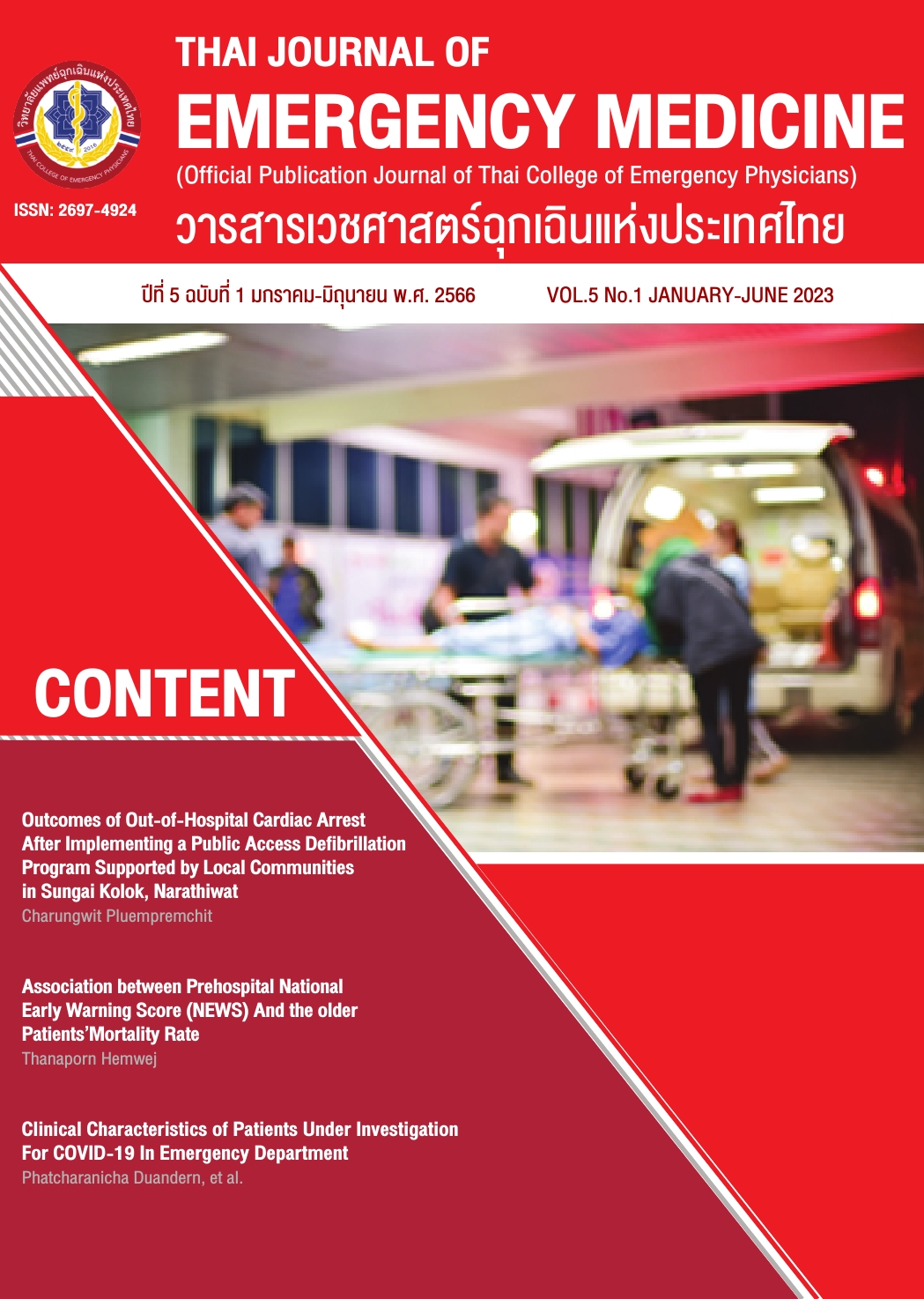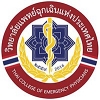Lung ultrasound score for predicting endotrcheal tube intubation in patients with community- acquired pneumonia: Pilot study
Keywords:
community-acquired pneumonia, lung ultrasound, lung ultrasound score, emergency departmentAbstract
Introduction
Community-acquired pneumonia is a common and high-mortality condition. A new trend of lung ultrasound has been recently utilized for diagnosis of pneumonia due to minimal radiation exposure and bedside convenience. Lung ultrasound score has been known for its capabilities for assessing severity, mortality, and length of hospital stay in several conditions. However, it has not been investigated in patients presenting with community-acquired pneumonia. Therefore, we aimed to evaluate the association between lung ultrasound scores and 72-hour endotracheal intubation.
Methods
A pilot observational study was conducted in an emergency department from March 2022 to April 2023. We enrolled all patients who were at least 18 years old with a diagnosis of community-acquired pneumonia and excluded patients with pregnancy, receiving mechanical ventilation at emergency department arrival, COVID-19 infection, and do-not-resuscitate orders. All eligible patients underwent a 12-region lung ultrasound and were rated a calculated ultrasound score of 0–3 in each region. The sum of lung ultrasound scores in each region was analyzed to determine the association between lung ultrasound scores and 72-hour endotracheal intubation.
Results
A total of 20 patients were analyzed. We observed that the increased lung ultrasound score was associated with 72-hour endotracheal intubation (p = 0.02). The receiver operator characteristic analysis indicated an area under the curve of 0.83 (95% CI, 0.6-1.0). In addition, the optimal cut-off value of the lung ultrasound score value for predicting 72-hour endotracheal intubation was 19, which demonstrated the highest sensitivity of 75% (95%CI, 34.9-96.8), a specificity of 83.3% (95%CI, 51.6-97.9), a positive predictive value of 75% (95%CI, 44.3-91.9), and a negative predictive value of 83.3% (95%CI, 59.5-94.5).
Conclusions
An increased lung ultrasound score was associated with 72-hour endotracheal intubation. Since it was conducted as a pilot study, further research is required to validate its outcome.
References
Metlay JP, Waterer GW, Long AC, Anzueto A, Brozek J, Crothers K, et al. Diagnosis and treatment of adults with communityacquired pneumonia. Am J Respir Crit Care Med. 2019;200:E45-67. https://doi.org/10.1164/rccm.201908-1581ST
Mandell LA, Wunderink RG, Anzueto A, Bartlett JG, Campbell GD, Dean NC, et al. Infectious Diseases Society of America/ American Thoracic Society Consensus Guidelines on the management of communityacquired pneumonia in adults. Clin Infect Dis. 2007;44 Suppl 2(Suppl 2):S27-S72. https://doi.org/10.1086/511159
Ananda-Rajah MR, Charles PGP, Melvani S, Burrell LL, Johnson PDR, Grayson ML. Comparing the pneumonia severity index with CURB-65 in patients admitted with community acquired pneumonia. Scand J Infect Dis. 2008;40:293-300. https://doi.org/10.1080/00365540701663381
Fine MJ, Auble TE, Yealy DM, Hanusa BH, Weissfeld LA, Singer DE, et al. A prediction rule to identify low-risk patients with community-acquired pneumonia. N Engl J Med. 1997;336:243-250. https://doi.org/10.1056/NEJM199701233360402
Charles P, Wolfe R, Whitby M, Fine MJ, Fuller A, Stirling R, et al. SMART-COP: A tool for predicting the need for intensive respiratory or vasopressor support in community- acquired pneumonia. Clin Infect Dis. 2008;47:375-84. https://doi.org/10.1086/589754
Lim WS, Van Der Eerden MM, Laing R, Boersma WG, Karalus N, Town GI, et al. Defining community acquired pneumonia severity on presentation to hospital: an international derivation and validation study. Thorax. 2003;58:377-382. https://doi.org/10.1136/thorax.58.5.377
Ye X, Xiao H, Chen B, Zhang SY. Accuracy of lung ultrasonography versus chest radiography for the diagnosis of adult community-acquired pneumonia: Review of the literature and meta-analysis. PLoS One. 2015;10:e0130066. https://doi.org/10.1371/journal.pone.0130066
Song G, Qiao W, Wang X, Yu X. Association of Lung Ultrasound Score with Mortality and Severity of COVID-19: A Meta-Analysis and Trial Sequential Analysis. Int J Infect Dis. 2021;108:603-609. https://doi.org/10.1016/j.ijid.2021.06.026
Dell'Aquila P, Raimondo P, Racanelli V, De Luca P, De Matteis S, Pistone A, et al. Integrated lung ultrasound score for early clinical decision-making in patients with COVID-19: results and implications. Ultrasound J. 2022;14(1):21. https://doi.org/10.1186/s13089-022-00264-8
Ji L, Cao C, Gao Y, Zhang W, Xie Y, Duan Y, et al. Prognostic value of bedside lung ultrasound score in patients with COVID-19. Crit Care. 2020;24(1):700. https://doi.org/10.1186/s13054-020-03416-1
Bobillo-Perez S, Sorribes C, Gebellí P, Lledó N, Castilla M, Ramon M, et al. Lung ultrasound to predict pediatric intensive care admission in infants with bronchiolitis (LUSBRO study). Eur J Pediatr. 2021;180:2065-2072. https://doi.org/10.1007/s00431-021-03978-4
Raimondi F, Migliaro F, Corsini I, Meneghin F, Dolce P, Pierri L, et al. Ultrasound Score Progress in Neonatal Respiratory Distress Syndrome. Pediatrics. 2021;147(4): e2020030528. https://doi.org/10.1542/peds.2020-030528
Zong H, Huang Z, Zhao J, Lin B, Fu Y, Lin Y, et al. The Value of Lung Ultrasound Score in Neonatology. Front Pediatr. 2022;10:791664. https://doi.org/10.3389/fped.2022.791664
Caltabeloti FP, Monsel A, Arbelot C, Brisson H, Lu Q, Gu WJ, et al. Early fluid loading in acute respiratory distress syndrome with septic shock deteriorates lung aeration without impairing arterial oxygenation: A lung ultrasound observational study. Crit Care. 2014;18:R91. https://doi.org/10.1186/cc13859
Yin W, Zou T, Qin Y, Yang J, Li Y, Zeng X, et al. Poor lung ultrasound score in shock patients admitted to the ICU is associated with worse outcome. BMC Pulm Med. 2019;19:1. https://doi.org/10.1186/s12890-018-0755-9
Santos TM, Franci D, Coutinho CMG, Ribeiro DL, Schweller M, Matos-Souza JR, et al. A simplified ultrasound-based edema score to assess lung injury and clinical severity in septic patients. Am J Emerg Med. 2013; 31:1656-1660. https://doi.org/10.1016/j.ajem.2013.08.053
Volpicelli G, Elbarbary M, Blaivas M, Lichtenstein DA, Mathis G, Kirkpatrick AW, et al. International evidence-based recommendations for point-of-care lung ultrasound. Intensive Care Med. 2012;38: 577-591 https://doi.org/10.1007/s00134-012-2513-4
Giorno EPC, Foronda FK, De Paulis M, Bou Ghosn DSN, Couto TB, Sa FVM, et al. Point-of-care lung ultrasound score for predicting escalated care in children with respiratory distress. Am J Emerg Med. 2023;68:112-118. https://doi.org/10.1016/j.ajem.2023.02.035
Downloads
Published
How to Cite
License
Copyright (c) 2023 Thai Collage of Emergency Physicians

This work is licensed under a Creative Commons Attribution-NonCommercial-NoDerivatives 4.0 International License.
บทความที่ได้รับตีพิมพ์ในวารสารเวชศาสตร์ฉุกเฉินแห่งประเทศไทย ถือเป็นเป็นลิขสิทธิ์ของ วิทยาลัยแพทย์เวชศาสตร์ฉุกเฉินแห่งประเทศไทย
กรณีที่บทความได้รับการตีพิมพ์ในวารสารเวชศาสตร์ฉุกเฉินแห่งประเทศไทยแล้ว จะตีพิมพ์ในรูปแบบอิเล็กทรอนิกส์ ไม่มีสำเนาการพิมพ์ภายหลังหนังสือเผยแพร่เรียบร้อยแล้ว ผู้นิพนธ์ไม่สามารถนำบทความดังกล่าวไปนำเสนอหรือตีพิมพ์ในรูปแบบใดๆ ที่อื่นได้ หากมิได้รับคำอนุญาตจากวารสารเวชศาสตร์ฉุกเฉินแห่งประเทศไทย




